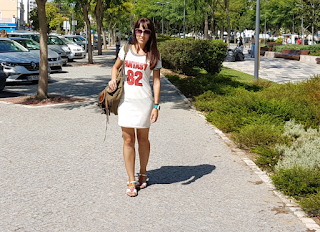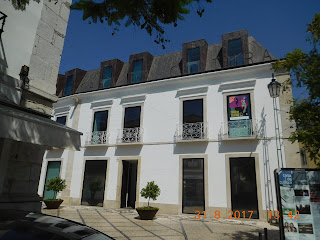Thursday. The last day of August and the previous day before Avante. I took the opportunity to visit the city and seeing new places in the city. Here the pictures:
Bowl of cereal and milk, my favourite breakfast from when I was little
This year commemorates the centenary of the Revolution of October
My favourite biscuits of Pingo Doce... Delicious and crispy vanilla cookies
After breakfast we (Nina and I) went for a stroll in the city...
A five minute from the Bocage Square the historical center – is the Jesus Convent (Convento de Jesus de Setúbal), XV century monument whose facade was recently restored. Where works the Museu de Setúbal... This is a historical religious building in Setubal, which served a monastery of Poor Clare nuns. It is one of the first buildings in the Manueline style, the Portuguese version of late Gothic. The cloisters of the complex houses a museum of the monastery (Museu de Jesus)
Intricate Manueline ribbed vaulting of the main chapel
Nave and choir
The church is rather narrow and consists of a nave and two side aisles of the same height, unifying inner space as in a hall church. Each pillar of the nave, supporting a pointed arch, is composed of three intertwined subcolumns in rough granite. The side aisles are supported by semi-barrel vaults. The main chapel of the church has a square shape. It is covered by an exuberant late Gothic star-ribbed vaulting with decorative bosses. Some of the ribs of the vault have the shape of a twisted rope, again anticipating a common theme in Manueline vaultings throughout the country. The main altar and the pulpit date from the 18th century
Tile panels
The exterior of the church. The main portal is in the middle of the façade; the apse is to the right. The decor and architecture of the Convent is unique and definitely helped to launch the style "Manueline"
1 October next will be the municipal elections and the CDU, PCP-PEV (Coligação Democrática Unitária in Portuguese, The Unitary Democratic Coalition in English) is an electoral and political coalition between the Portuguese Communist Party (Portuguese: Partido Comunista Português or PCP) and the Ecologist Party "The Greens" (Portuguese: Partido Ecologista "Os Verdes" or PEV). The coalition also integrates the political movement Democratic Intervention (Portuguese: Intervenção Democrática or ID)
The coalition was formed for the first time in 1987 in order to run to the simultaneous legislative election and European Parliament election that were held on July 19 of that year. Since the beginning of the coalition, the member parties have never participated separately in any election. The Communist Party is the major force inside it and has the majority of places in the electoral lists, however, the Greens also have an important presence. Each party has its own parliamentary group and counts as a separate party in official issues.
At a local level, the coalition usually presents lists in almost every municipality and both Communists and Greens may occupy first place on the lists. As the Greens have a smaller structure, the offices of the Communist Party are used as offices of the coalition
Ancient buildings
Luisa Todi Avenue
Nymphs Fountain (Fonte das Ninfas)
Rua Cláudio Lagrange. In the photo below we can see the back of the Municipal Gallery of the Old Banco de Portugal. This is an old bank office building but never the less one of the most symbolic on the avenida Luisa Todi, who has being transferred into the Galeria Municipal do Banco de Portugal, which is now a gallery who has two permanent expositions with a high patrimonial value...
Walking along the majestic avenue Luisa Todi in the city centre. The surrounding area is well looked after and definitely a good place for a walk. Lots to see on this avenue...
Visiting the Jardim da Beira-Mar
In the Garden Jardim Engenheiro Luís da Fonseca (better known as Jardim da Beira-Mar) there are also interesting things to discover...
The waterfront of Setubal
Walking along the waterfront
A bus bar behind me
The old tree, a Melaleuca (Melaleuca armillaris)
The public interest of its aesthetic value was recognized in 2009 by the Portuguese authorities. The species originates in Australia where it is called Cajeput Tree, which comes from the Indonesian language and means "white wood". In the United States it is known as Paperbark Tree, because its trunk peels like sheets of paper
This mast belonged to the ship Câmara Pestana. Over 10 years, on more than 500 ladders, at the Sezil-Outao dock, it transported about 2 million tons of cement to Madeira, ensuring regular supplies, sometimes in very difficult situations. SECIL's tribute to its crews
Nossa Senhora do Cais - Padroeira dos Pescadores, the patron saint of fishermen
View on Troia on the other side of the bay
In the background of the picture is the Statue of Saint Francis Xavier
Historical buildings well preserved
The bandstand (o coreto) on Avenida Luísa Todi
This avenue has two lanes of traffic in both directions divide by a pedestrian walkway
Souvenirs!
The historical centre of Setubal
This is the historic center of Setúbal. Every street, building, facade, sidewalk or porch is a piece of memory of the city. Here, the past recedes periods up to Roman and Phoenician, but a walk in downtown is more than a history lesson; is also wander in a vast open shopping area...
Central square of the city of Setubal with the name of the Bocage Square, named after the poet Manuel Maria du Bocage, born in this city in 1765, the center of a square pedestal has a statue of the poet
Municipality flags (Portugal and Setubal)
Town hall building
The Culture House is a dynamic hub of artistic activity developed in the County, reconciling different valences. A visit to the House of Culture may lead to a mix of emotions and sensations, once the versatility of the space offers visitors a diverse cultural offering
At the entrance, shop / reception gives the welcome to visitors and parallel functions as bookstore, disco and video library. This area are marketed productions of House of Culture or other directly related to artistic production and culture of associations based there
For the moments of conviviality, leisure or even to break the visit, you can go to the Café of the Arts that (Café das Artes), besides the cafeteria service, enables the performance of different types of initiatives, as cafés-concerts or meetings... What a wonderful cafe!
I love this graffiti that is on the wall

Vertical gardens on the esplanade of the Café das Artes
This small vertical garden has some strawberries planted and coffee customers can pick them up and eat them! This is a rare and beautiful space, very original... A quiet place to hang out or read a book...
Rising to first floor, the focus is on the Main Hall, meeting room that also hosts concerts and other artistic notes. Right there beside, Works Sala José Afonso - renowned figure of popular music -, a space for the realization, among other initiatives, Conference, musical and scenic events
Near the entrance, enhancement for the Exhibition Gallery, an area reserved for the performing arts and shows that can simultaneously accommodate more than one exposure
This trilogy has as main objective to collect signs and images present in the cities with stories to tell, presenting details and details that today tend to fall into oblivion - they are the covers of the mailboxes of the mails that ask for letters, the walls and finally the bells, which were the first witnesses of those who approached the houses and made themselves known...
These images as well as collectibles are also a way of preserving some of the beauty that exists beyond the inanimate object, at the same time as it forces us to confront with the abandonment to which we subject everything that surrounds us...
In the first chapter - Send me Letters - the letters and words were attached to each of the photo doors. In this new presentation, the aesthetics of the different bells are portrayed, each time more uniform and silenced
Words related to the violence against women
The satirical poet Manuel Maria Barbosa du Bocage (1765-1805) and Luísa Rosa de Aguiar Todi (1753–1833) a mezzo-soprano opera singer are the most famous citizen of Setubal
Praça de Bocage
Lunchtime!
Serradura reserved for me!!! 😋



































































































































.jpg)

No comments:
Post a Comment